Physical Address
304 North Cardinal St.
Dorchester Center, MA 02124
Large or complex atherosclerotic plaques in the proximal segment of the aorta are a potential cause of ischemic stroke in individuals older than age 60 years.
The magnitude of the risk depends on the morphologic characteristics of the plaque (thickness, ulceration, presence of mobile components).
Transesophageal echocardiography (TEE) is the most widely used and sensitive diagnostic technique for their detection, but magnetic resonance imaging (MRI), computed tomography (CT), or positron emission tomography (PET)/CT are also used.
Unsuspected proximal aortic plaques increase the stroke risk during cardiac catheterization and cardiac surgery, requiring screening before the procedure and possibly alteration of the technique used to perform it.
Hypercoagulability may increase the possibility of superimposed thrombus formation on a plaque and therefore the associated stroke risk.
The best preventive treatment to decrease embolic events in patients with proximal aortic plaques is still controversial; statins and antiplatelet agents are recommended.
Systemic anticoagulation appears indicated in the case of documented mobile superimposed thrombus.
Surgical aortic endarterectomy carries great risk of embolization and should be reserved to highly selected cases.
The presence of atherosclerotic plaques in the aorta is a risk factor for ischemic stroke. The proximal portion of the aorta, where the blood vessels that supply the brain originate, may become the source for cerebral embolism. This chapter will review the principal studies on the association between aortic plaques and ischemic stroke, and the related diagnostic and therapeutic issues.
Atherosclerosis in the aorta develops throughout life, becoming especially evident after the fourth decade of life; the prevalence and number of atherosclerotic lesions increases continuously thereafter. In the Stroke Prevention: Assessment of Risk in a Community (SPARC) study, the prevalence of “simple” (less than 4 mm in thickness, without ulceration or mobile debris) or “complex” (≥4mm thick, or with complex features) atherosclerotic lesions, was evaluated by transesophageal echocardiography (TEE) in 588 volunteers older than the age of 44 years. Atherosclerosis of any degree was identified in the ascending aorta, aortic arch, and descending aorta in 8.4%, 31.0%, and 44.9%, respectively. Corresponding figures for complex atherosclerosis were 0.2%, 2.2%, and 6.0%. Any atherosclerosis prevalence increased from approximately 17% in the 45–54 years subgroup to more than 80% in the older than age 75 subgroup. Complex atherosclerosis was virtually absent in the younger subgroup but present in more than 20% of subjects after age 75. In a TEE study on healthy volunteers older than the age of 59, simple plaques in the aortic arch were detected in 22% and complicated plaques (≥5 mm in thickness or with irregular, ulcerated surface) in 4%. The prevalence of aortic atherosclerosis in the general population varies with the characteristics, and especially risk factors distribution, of the sample studied. In the triethnic study group of 209 stroke-free volunteers older than age 55 in the Aortic Plaque and Risk of Ischemic Stroke (APRIS) study, aortic arch atherosclerosis of any degree was present in 62.2%, large (≥4 mm) arch plaques in 23.9%. These figures, considerably higher than those of the other studies, were associated with a greater burden of atherosclerotic risk factors. Compared with SPARC, the APRIS study group had higher frequencies of diabetes (23.0% vs. 8.9%), hypertension (69.4% vs. 55.2%), and past and current smoking history (60.3% vs. 39.0% and 16.1% vs. 8.2%, respectively).
A strong association between aortic arch plaques and ischemic stroke was first reported by Amarenco and colleagues in an autopsy case-control study. Patients who had died from a stroke had a far greater frequency of ulcerated proximal aortic plaques than patients who had died from other neurologic diseases (26% vs. 5%; age-adjusted odds ratio [OR] 4.0; 95% confidence interval [CI], 2.1–7.8). Importantly, the highest frequency of ulcerated plaques was observed in patients with unexplained (cryptogenic) stroke (61% vs. 28%; adjusted OR 5.7; 95% CI, 2.4–13.6), providing a potential etiologic mechanism. The lack of association between ulcerated plaques and significant carotid artery stenosis or atrial fibrillation suggested an independent role of aortic plaques on stroke risk. Among patients with ulcerated plaques, only 3% were younger than 60 years.
In another necropsy study on 120 unselected patients, complicated aortic arch plaques were significantly associated with arterial embolism (OR 5.8; 95% CI, 1.1–31.7), independent of and with similar strength as severe ipsilateral carotid artery disease and atrial fibrillation.
TEE is the most sensitive and widely used technique for examining the association between aortic plaques and ischemic stroke in vivo. The proximity of the esophagus to the aorta and the absence of interposed structures allow the use of high-frequency ultrasound transducers, which provide high-resolution images. The segment of aorta proximal to the take-off of the left subclavian artery is the focus of the examination. The ascending aorta can be accurately visualized by TEE from the aortic valve level to the initial curvature of the arch ( Fig. 33.1 ). The mid and distal portions of the aortic arch are also visualized in all patients ( Fig. 33.2 ). A small portion of the vessel (proximal arch) may not be visualized due to the interposition of the trachea and is a “blind spot” of the examination. By TEE, an accurate assessment is possible of the presence and thickness of plaques ( Fig. 33.3 ), as well as ulcerations ( Fig. 33.4 ) or superimposed thrombus ( Figs. 33.5–33.7 ; ![]() ). TEE is highly sensitive and specific for plaque detection. , Its diagnostic accuracy for superimposed thrombus is also high (sensitivity 91%, specificity 90%). However, the sensitivity for detecting small ulcerations of the plaque surface, which may carry additional embolic risk, , , is lower (approximately 75%). Reproducibility of TEE measurements of plaque thickness is very good, with agreement of 84%–88% for large (≥4 mm) plaque.
). TEE is highly sensitive and specific for plaque detection. , Its diagnostic accuracy for superimposed thrombus is also high (sensitivity 91%, specificity 90%). However, the sensitivity for detecting small ulcerations of the plaque surface, which may carry additional embolic risk, , , is lower (approximately 75%). Reproducibility of TEE measurements of plaque thickness is very good, with agreement of 84%–88% for large (≥4 mm) plaque.
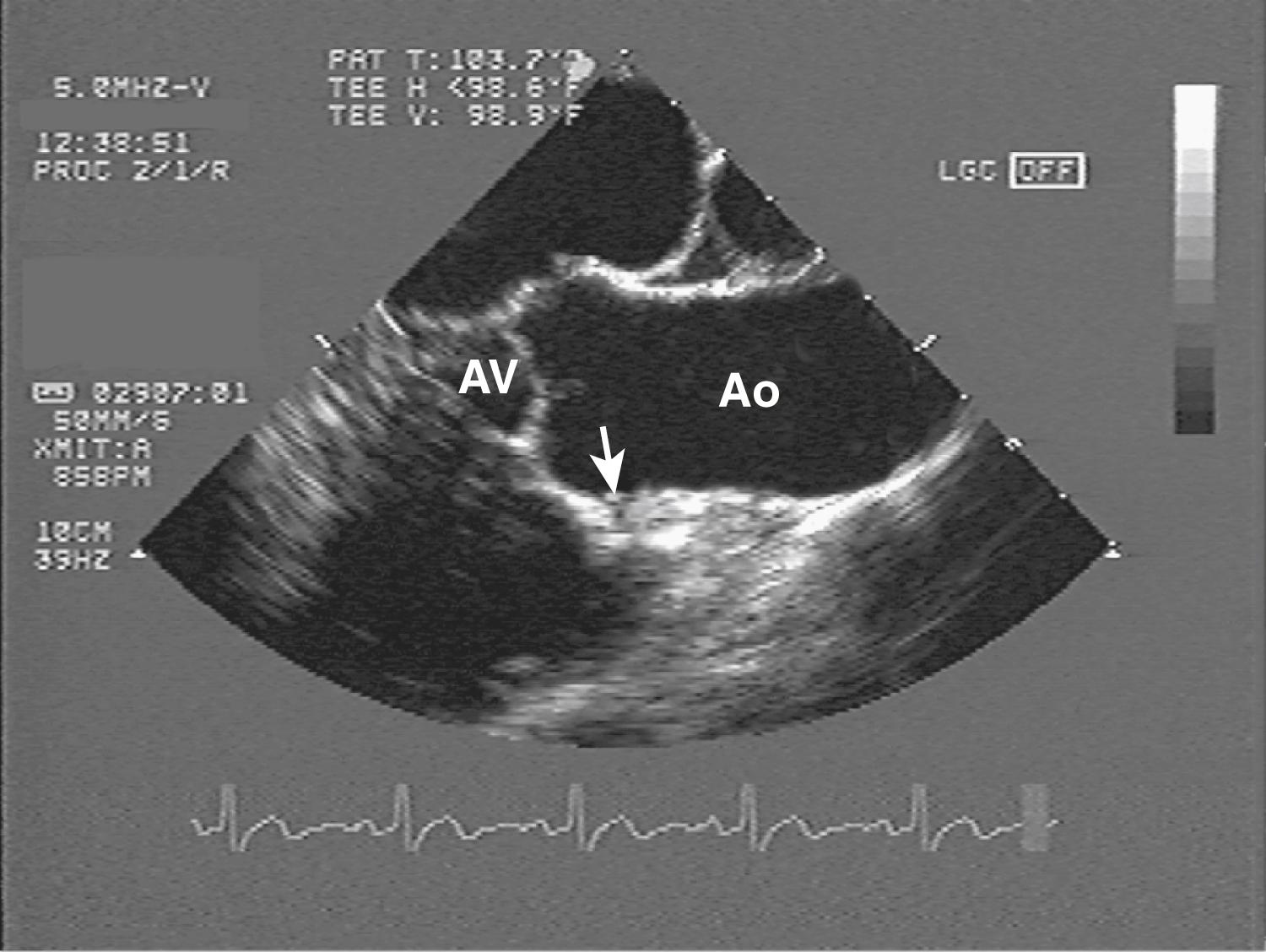
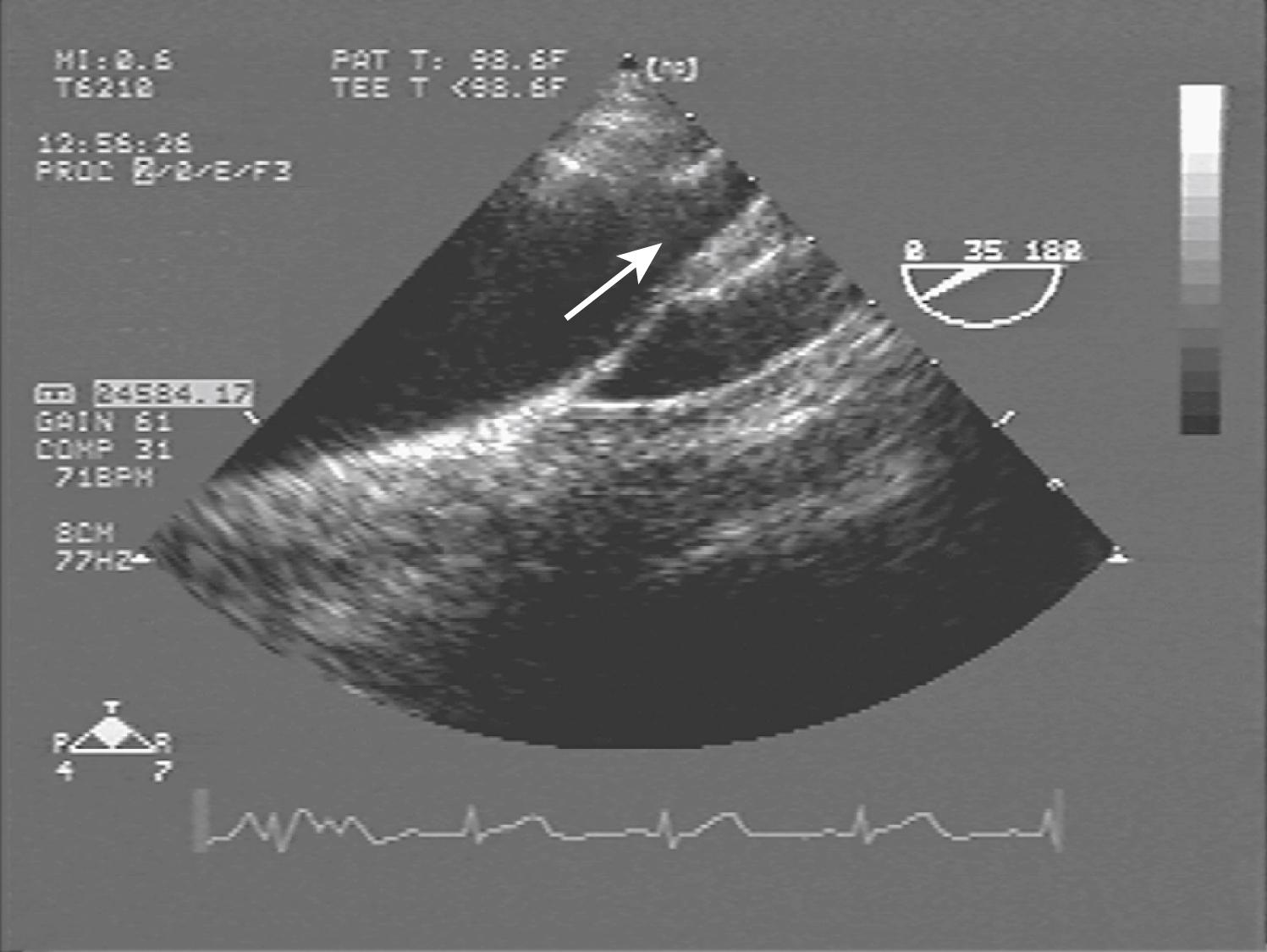
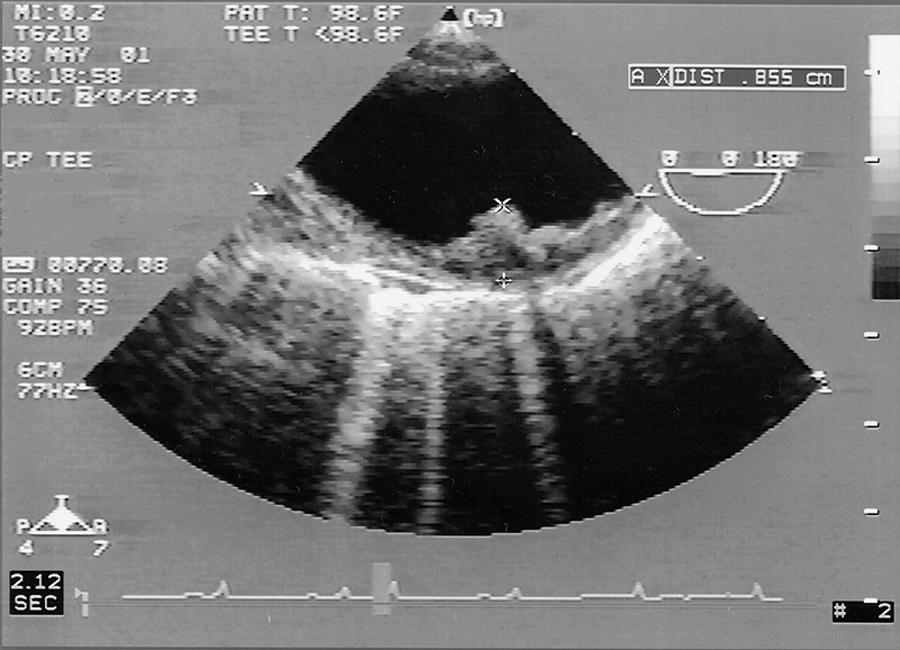
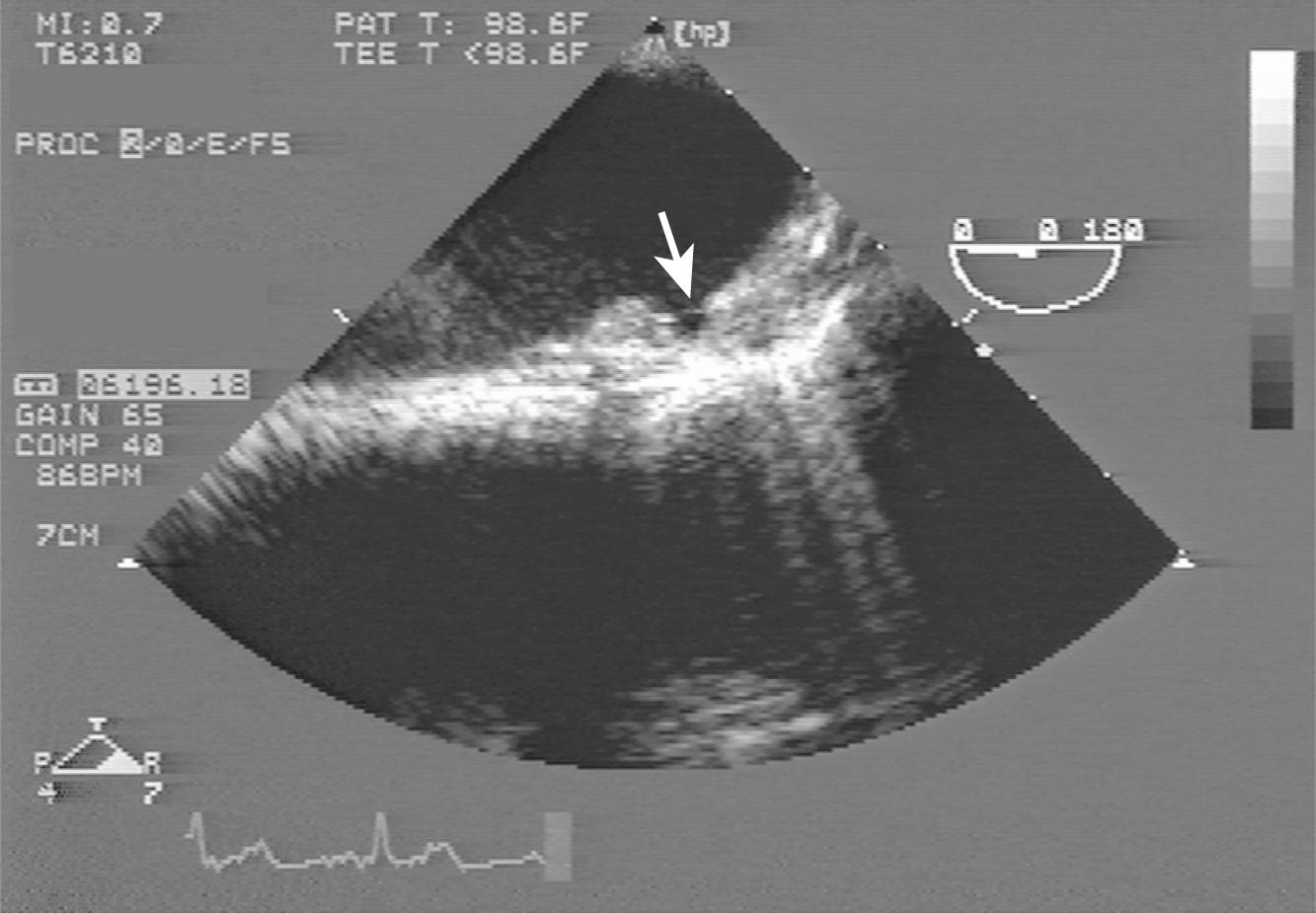
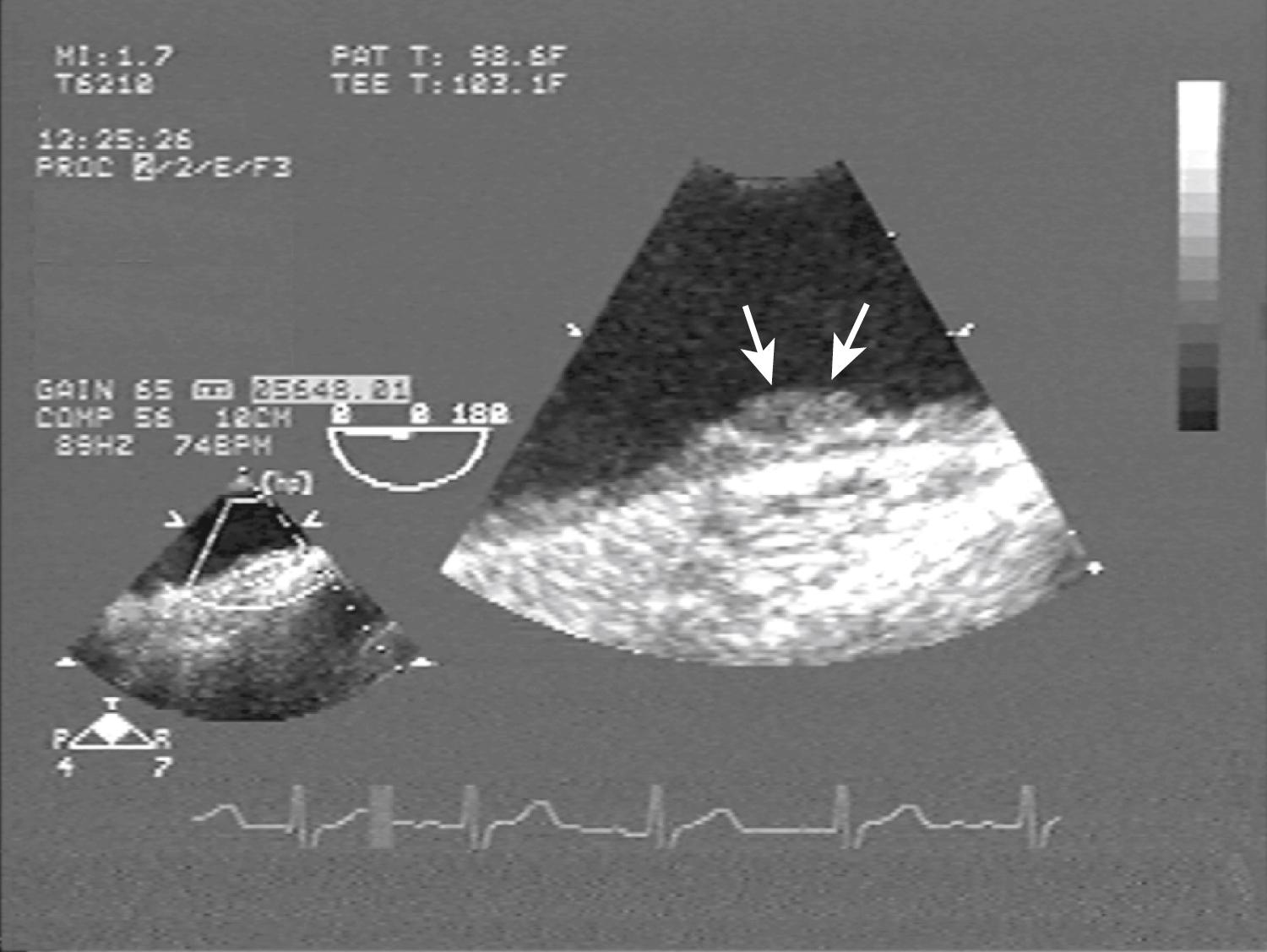
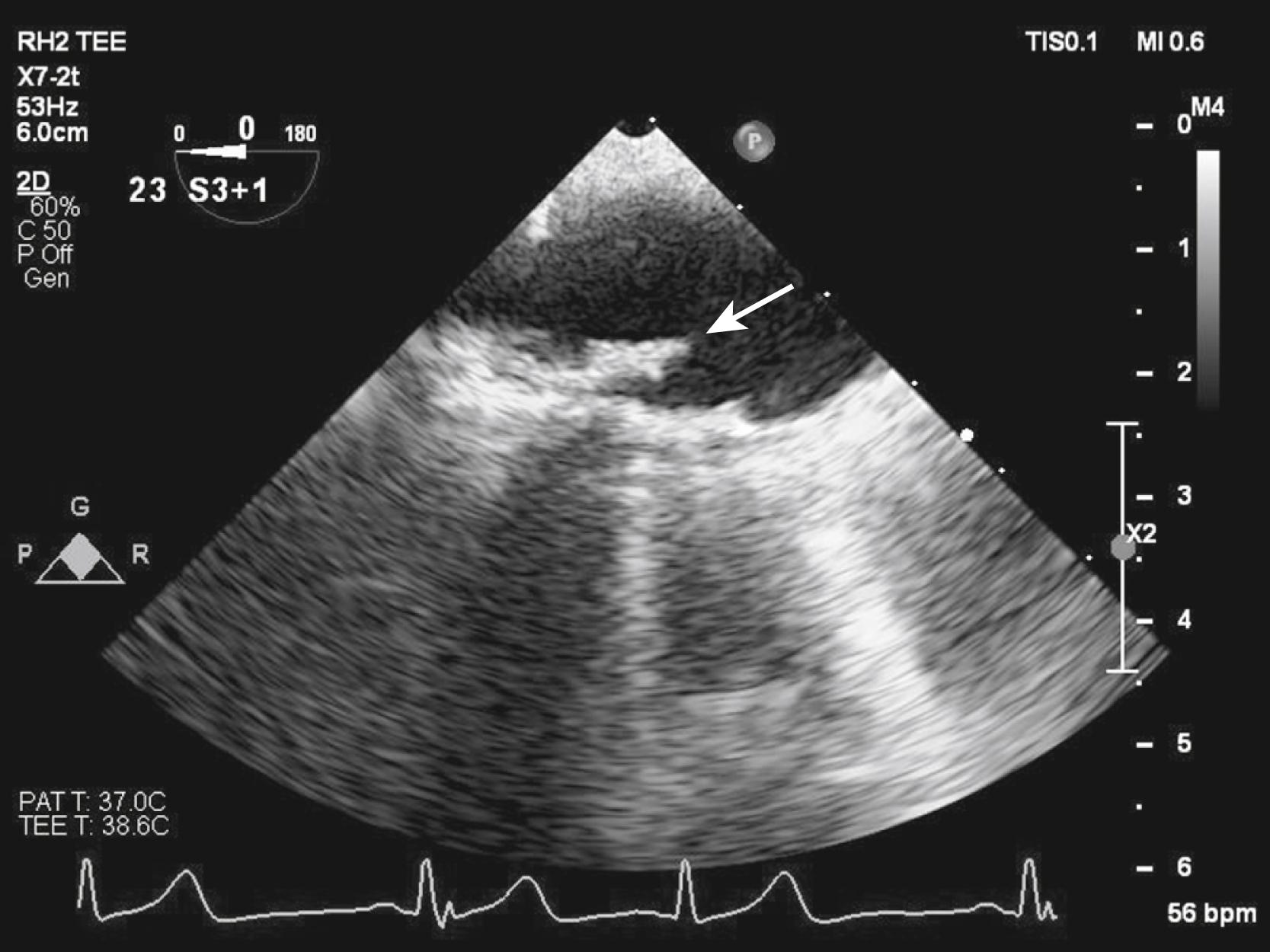
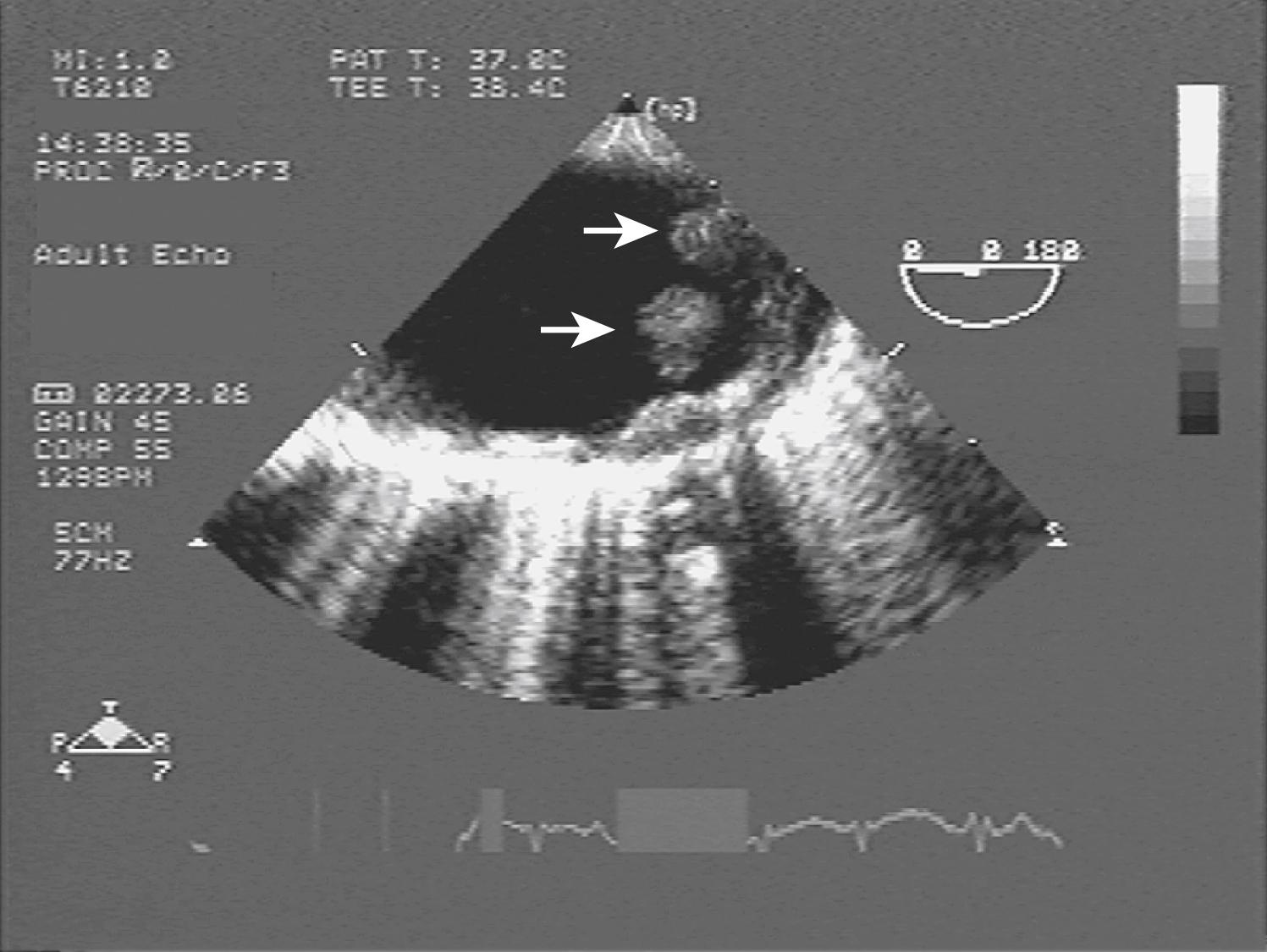
TEE is a safe, although semi-invasive, diagnostic test. Major complications are uncommon and mainly due to unsuspected preexisting esophageal disease. In more than 10,000 patients, one death was observed. In an additional 2.7%, there was unsuccessful intubation (1.9%) or patient intolerance (0.8%). Similar results were obtained in 15,381 consecutive patients, with 2 deaths (0.01%) and an incidence of complications of 1.7%. In 901 patients, intubation was unsuccessful in 1.2% of cases, with no deaths and a low incidence (0.6%) of major complications. TEE performance is feasible in the majority of stroke patients and can be safely performed in patients of very advanced age.
Tunick and colleagues first reported an increased frequency of aortic plaques 5 mm or greater in 122 patients with a history of arterial embolism compared with 122 age- and sex-matched patients with other diagnoses (27% vs. 9%; OR 3.2; 95% CI, 1.6–6.5). This retrospective study, not adjusted for other potential embolic sources, was followed by other case-control studies that are summarized in Table 33.1 . Amarenco and colleagues studied 250 patients with acute ischemic stroke older than the age of 60 and 250 controls. Arch plaques between 1 and 3.9 mm thick were associated with stroke after adjustment for conventional risk factors (adjusted OR 4.4), but the risk increased sharply for plaques 4 mm or greater (adjusted OR 9.1). In addition, the risk was independent of presence of carotid stenosis and atrial fibrillation. The authors speculated that the sharp increase in risk observed for larger plaques might depend on a more frequent presence of superimposed thrombus, included in the measurement of plaque thickness, and to higher frequency of mobile components, a circumstance confirmed in other studies. Plaques 4 mm or greater were significantly more frequent in patients with cryptogenic stroke than in patients with stroke of determined origin (28.2% vs. 8.1%; OR 4.7; 95% CI, 2.2–10.1).
| Study (Reference No.) | Cases/Controls (N) | Age (Years) | Type of Atheroma | Controls (%) | Patients With Stroke (%) | Adjusted Odds Ratio ∗ (95% CI) |
|---|---|---|---|---|---|---|
| Amarenco et al. | 250/250 | ≥60 | 1–3.9 mm | 22 | 46 | 4.4 (2.8–6.8) |
| ≥4 mm | 2 | 14 | 9.1 (3.3–25.2) | |||
| Jones et al. | 215/202 | ≥60 | <5 mm, smooth | 22 | 33 | 2.3 (1.2–4.2) |
| ≥5 mm, complex | 4 | 22 | 7.1 (2.7–18.4) | |||
| Di Tullio et al. | 106/114 | ≥40 | ≥5 mm | 13 | 26 | 2.6 (1.1–5.9) |
| 30/36 | <60 | 3 | 3 | 1.2 (0.7–20.2) | ||
| 76/78 | ≥60 | 18 | 36 | 2.4 (1.1–5.7) | ||
| Di Tullio et al. | 255/209 | ≥55 | ≥4 mm | 24 | 49 | 2.4 (1.3–4.6) |
∗ Adjusted for conventional stroke risk factors (also see text).
Similar results, except for the association with cryptogenic stroke, were obtained by Jones et al., who studied 215 stroke patients and 202 healthy volunteers older than age 59 (see Table 33.1 ). Plaques 5 mm or greater or with ulcerated/mobile components were associated with much greater stroke risk (adjusted OR 7.1) versus no plaque than smaller, smooth plaques (adjusted OR 2.3). However, the frequency of large or complex plaques was similar in patients with cryptogenic stroke (20%) and patients with stroke of determined origin (23%).
We studied 106 stroke patients older than the age of 40 and 114 age- and gender-matched controls, detecting an increased risk of stroke associated with aortic plaques 5 mm or greater (adjusted OR 2.6). The risk was entirely due to the subgroup of patients older than age 59, while the prevalence of large plaques was very low (3%) below that age in both stroke patients and controls (see Table 33.1 ).
Using epiaortic ultrasonography, Davila-Roman and colleagues studied the prevalence of aortic plaques in 1200 subjects older than the age of 49 years undergoing cardiac surgery, 158 of them with a previous embolic event. They found plaques 3 mm or greater in 26.6% of patients with a previous cerebrovascular event and in 18.1% of those without it. Aortic plaques, arterial hypertension, atrial fibrillation, and carotid artery stenosis were independently associated with neurologic events.
More recently, we reported similar results in 255 stroke patients and 209 age-, gender-, and race/ethnicity-matched controls of APRIS. Large aortic arch plaques (≥4 mm) were again found to be associated with an increased stroke risk after adjustment for other stroke risk factors (adjusted OR 2.4; see Table 33.1 ). Complex plaque morphology and coexisting hypercoagulability increased the stroke risk, as will be discussed later.
Retrograde embolization to the brain from the proximal segment of the descending aorta has been known to occur, although its actual involvement as a stroke mechanism is difficult to quantify. Retrograde flow from aortic segments containing large plaques was visualized by magnetic resonance imaging (MRI) in 28 of 94 stroke patients (29.8%), potentially affecting all brain territories ; retrograde flow visualized by four-dimensional (4D) MRI into the supra-aortic vessels showed 26% concordance with infarct location in 35 patients with cryptogenic stroke. In a meta-analysis on 4000 patients, complex plaques in the descending aorta were significantly more frequent in stroke patients than in controls (25.4% vs. 6.1%; P = .001) but not in cryptogenic strokes compared with strokes of other etiology (21.8% vs. 28.3%; P = .06). In 1527 participants in the Framingham Offspring studies who underwent both aortic and brain MRI, atherosclerosis in the descending aorta was not associated with an increased risk of future stroke or transient ischemic attack (TIA) over a median follow-up of 7 years.
The role of aortic arch plaques as a risk factor for peripheral and cerebral embolization has also been confirmed prospectively ( Table 33.2 ), comparing the recurrence rate of embolic events in patients with and without plaques. After a mean follow-up of 14 months, Tunick and colleagues noted a significantly greater incidence of cerebral or peripheral embolic events in 42 patients with protruding aortic atheromas compared with control subjects matched for age, gender, and hypertension (33% vs. 7%; relative risk [RR] 4.3). Similar results were reported by Mitusch and colleagues in 47 patients with large or mobile arch plaques and 136 patients with small or no plaque. Recurrence rate of embolic events was 13.7%/year in the former group and 4.1%/year in the latter (RR 4.3). In a French multicenter study on 331 stroke patients 60 years or older, arch plaques 4 mm or greater were associated with an almost fourfold increase in risk of recurrent stroke after adjusting for carotid stenosis, atrial fibrillation, peripheral artery disease, and conventional risk factors (see Table 33.2 ). The recurrence rate was highest in patients whose index stroke was cryptogenic (16.4 per 100 person-years). The incidence of combined vascular events was also significantly greater in patients with large plaques (RR 3.5; see Table 33.2 ). In 236 patients with ischemic stroke, Tanaka and colleagues observed an increased risk of recurrent stroke or myocardial infarction in patients with arch plaques 3.5 mm or greater followed for 42 months (see Table 33.2 ). Fujimoto and colleagues followed 283 patients with embolic stroke and no significant occlusive lesion in their cerebral arteries for a mean of 3.4 years. Patients who experienced a recurrent stroke (32, or 11.3%) had significantly increased prevalence of arch plaques 4 mm or greater (41% vs. 22%) and of plaque extension to the cephalic branches (63% vs. 39%), and the combination of these two features had the highest recurrence risk (see Table 33.2 ). We more recently reported on the incidence of recurrent stroke and death in 516 patients with acute ischemic stroke treated with aspirin or warfarin as part of the Patent Foramen Ovale in Cryptogenic Stroke Study (PICSS). Over a follow-up of 2 years, large plaques (≥4 mm) remained associated with an increased risk of events (adjusted hazard ratio [HR] 2.1), especially those with complex morphology (HR 2.6; see Table 33.2 ). The risk was highest among cryptogenic stroke patients, for both large plaques (HR 6.42; 95% CI, 1.62–25.46) and large-complex plaques (HR 9.50; 95% CI, 1.92–47.10). In the SPARC study, the association between aortic atherosclerosis and cerebrovascular events was questioned. In 581 community-derived subjects undergoing TEE, large (≥4 mm), ulcerated or mobile plaques were associated with a history of coronary artery disease (OR 2.35; 95% CI, 1.1–5.0) but not ischemic stroke (OR 1.37; 95% CI, 0.44–4.3). The inclusion of younger subjects (age cutoff was 45 years) may have diluted the strength of the association between aortic plaques and stroke. In addition, the prevalence of severe plaques in the proximal aorta was low (2.4%). However, we more recently reported similar findings from the follow-up of the APRIS control group (age older than 54 years), in which large arch plaques were also not associated with stroke and vascular events (HR 1.05; 95% CI, 0.37–3.03). These observations suggest that the risk of stroke from arch plaques incidentally detected in healthy subjects may be lower than that generally reported in the literature, which was obtained in subjects with previous stroke or peripheral embolic events, or referred for TEE because of other coexisting conditions.
| Study (Reference No.) | Aortic Plaque Present/Aortic Plaque Absent (N) | Follow-up (Months) | Type of Plaque | Aortic Plaque Absent (%) | Aortic Plaque Present (%) | Adjusted ∗ Relative Risk (95% CI) |
|---|---|---|---|---|---|---|
| Tunick et al. | 42/42 | 14 | ≥4 mm | 7 | 33 | 4.3 (1.2–15.0) |
| Mitusch et al. | 47/136 | 16 | ≥5 mm/mobile vs. <5 mm | 4.1/yr | 13.7/yr | 4.3 (1.5–12.0) |
| French Study of Aortic Plaques in Stroke † | 331 | 24–48 | ≥4 mm | 2.8/yr | 11.9/yr | 3.8 (1.8–7.8) |
| 5.9/yr | 26.0/yr | 3.5 (2.1–5.9) | ||||
| Tanaka et al. | 97/139 | 42 | ≥3.5 mm | not reported | not reported | 2.1 (1.2–3.7) |
| Fujimoto et al. | 51/232 | 40 | ≥4 mm, extending to branches | 2.9/person-yr | 9.8/person-yr | 2.4 (1.1–5.2) |
| Di Tullio et al. ‡ | 101/415 44/415 |
24 24 |
≥4 mm ≥4 mm, complex |
5.1/yr 5.1/yr |
13.4/yr 13.7/yr |
2.1 (1.04–4.3) 2.6 (1.1–5.9) |
∗ Adjusted for conventional stroke risk factors (also see text).
† Only study conducted on patients with ischemic stroke. Data in first row refer to recurrence rate of stroke; data in second row refer to recurrence rate of all embolic events.
The risk of stroke has been mainly established measuring the thickness of the plaque, with either 4 or 5 mm chosen as cutoffs. However, it is unclear whether plaque thickness is directly related to the stroke mechanism, or rather a marker of diffuse atherosclerosis, which could be in fact responsible for the increased risk. Differences in plaque-related stroke risk exist between genders. Aortic plaques 4 mm or greater were significantly more frequent in men than in women (31.5% vs. 20.3%; P = .025) and were associated with ischemic stroke in both men (adjusted OR 6.0; 95% CI, 2.1–16.8) and women (adjusted OR 3.2; 95% CI, 1.2–8.8). However, plaques 3–3.9 mm in thickness were significantly associated with stroke in women (adjusted OR 4.8; 95% CI, 1.7–15.0) but not in men (adjusted OR 0.8; 95% CI, 0.2–3.0). This observation suggests that plaque thickness, rather than identifying the actual culprit lesion for the stroke, may be a marker of diffuse atherosclerosis, including intracranial atherosclerosis, or of other conditions that may differ between genders, and are possibly related to the stroke mechanism. In any case, plaque progression, defined as increase in thickness over time, was found to be associated with increased incidence of vascular events. Among 117 patients with stroke or TIA, those who showed plaque progression over 1 year were significantly more likely to experience a vascular event (stroke, TIA, myocardial infarction, or death) than those with no plaque progression over a median follow-up of 1.7 years (51% vs. 11%; P < .0001).
The complex morphology of a plaque may be more directly related to the stroke mechanism than its thickness. Morphologic features of the plaque, such as ulceration or mobility, have been linked with an increased stroke risk, , , especially for cryptogenic stroke. In 152 elderly stroke patients and 152 age-matched controls, ulcerated or mobile plaques were found to be a much stronger risk factor for stroke than large but noncomplex plaques. Plaques 4 mm or greater were indeed associated with increased stroke risk (adjusted OR 4.3; 95% CI, 2.1–8.7); however, when they were divided on the basis of the presence or absence of ulceration (discrete indentation of at least 2 mm in width and depth) or mobile components, the stroke risk associated with those complex features was exceedingly high (adjusted OR 17.1; 95% CI, 5.1–57.3), whereas large but noncomplex plaques carried only a modest risk increase (adjusted OR 2.4; 95% CI, 1.1–5.1). The same remained true even after excluding patients with other stroke sources such as atrial fibrillation, carotid stenosis 60% or greater, or intracranial atherosclerosis. Cohen and colleagues studied the impact of plaque morphology (ulceration, hypoechoic components, or calcification) on the risk of recurrent vascular events in a prospective study on 334 stroke patients older than the age of 60 followed for 2–4 years. In patients with plaques 4 mm or greater, the presence of ulcerations or hypoechoic components did not increase the risk of vascular events. However, the absence of calcification was associated with the strongest increase in risk (adjusted RR 10.3; 95% CI, 4.2–25.2), whereas the presence of calcification decreased the risk (adjusted RR 1.2; 95% CI, 0.6–2.1), possibly signaling a more stable lesion. These observations suggest that, although plaque thickness represents the most readily available marker of embolic risk, the plaque’s morphologic features strongly affect its embolic potential, possibly calling for different therapeutic approaches in individual patients. Whenever TEE identifies a protruding, mobile component on a plaque, this represents thrombus superimposed to atherosclerotic material, and usually occurs on ulcerated plaques. This observation was confirmed by several studies that correlated TEE findings with the histopathologic examination. , , Mobile components superimposed to an aortic plaque are infrequently seen in stroke patients, ranging from 1.6% to 8.7% in different studies , , , , , , , ( Table 33.3 ). When present, however, they represent a very strong risk factor for brain embolization. In our study, mobile components superimposed to a plaque were present in 6.6% of elderly stroke patients and were associated with a more than 20-fold increase in the risk of stroke, after adjusting for other stroke risk factors. Occasionally, mobile thrombi without severe atherosclerosis can be seen in patients younger than 60 years who present with an embolic event (23 cases out of 27,855 TEE examinations in a multicenter cardiology study). These thrombi usually have insertion on small atherosclerotic plaques and appear to represent a rare variant of atherosclerotic disease in younger patients.
| Study | Patients (N) | Mobile Thrombi | |
|---|---|---|---|
| N | Percentage | ||
| Toyoda et al. | 62 | 3 | 4.8 |
| Nihoyannopoulos et al. | 152 | 3 | 2.0 |
| Jones et al. | 202 | 11 | 5.4 |
| Amarenco et al. | |||
| Unselected | 250 | 7 | 2.8 |
| Cryptogenic | 78 | 6 | 7.7 |
| Stone et al. | |||
| Unselected | 49 | 2 | 4.1 |
| Cryptogenic | 23 | 2 | 8.7 |
| Di Tullio et al. | 152 | 10 | 6.6 |
| Ueno et al. | 167 | 12 | 7.2 |
| Di Tullio et al. | 255 | 4 | 1.6 |
The potential for brain embolism from large plaques, and even more from complex plaques, has been confirmed using transcranial Doppler monitoring. Continuous monitoring of the blood flow into the middle cerebral arteries is obtained, which can be performed simultaneously on both sides, and maintained for prolonged periods of time. The passage of small particles produces characteristic high-intensity transient signals (HITSs) ( Fig. 33.8 ), whose identification can be enhanced through the application of appropriate filters. Using this technique for 30 minutes in 46 patients with acute ischemic stroke, Rundek and colleagues demonstrated the presence of HITSs in a much larger proportion of stroke patients with plaques 4 mm or greater than with small or no plaques, even in the absence of other TEE-detected possible embolic sources (70% vs. 18%; P = .007). Moreover, all patients with large and complex plaques were found to have HITSs, compared with 39% of patients with large but noncomplex plaques ( P = .005). Similar results for plaques 4 mm or greater and HITSs were obtained in cryptogenic stroke patients in a study by Castellanos et al., in which data on plaque complexity were not reported.
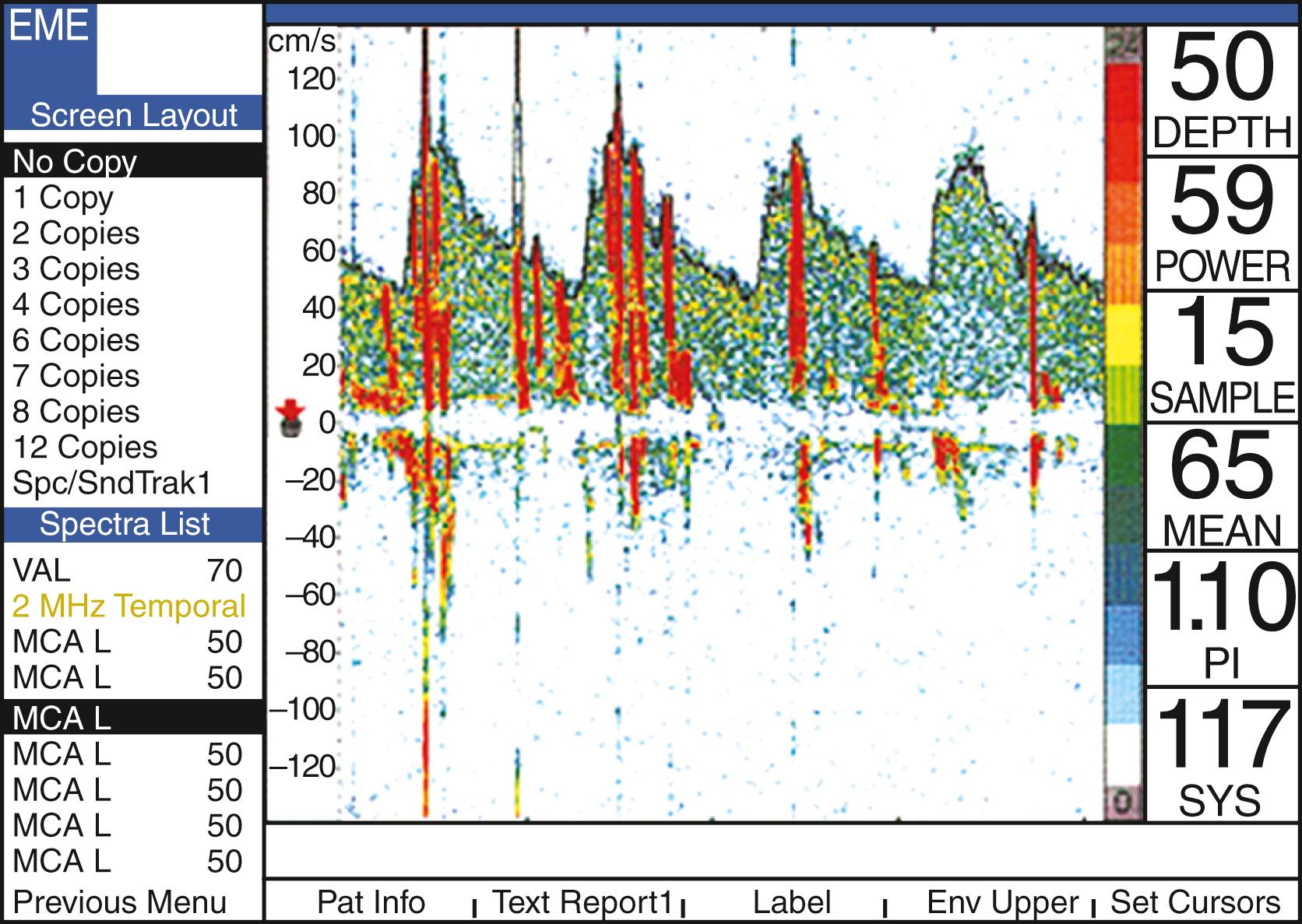
In summary, arch plaque thickness 4 mm or greater has been shown to be associated with increased stroke risk and remains a useful tool for risk stratification, although part of the risk may come from superimposed thrombus included in the measurement. Plaque thickness is also a marker of diffuse atherosclerosis, which may also play an important role in the stroke mechanism. The presence of complex morphologic features, and especially mobile components, appears more directly related to stroke mechanism in individual patients. Overall, the incidence of recurrent embolic events in patients with large or mobile aortic plaques has been estimated up to 14% per year, underscoring the need for effective secondary prevention strategies.
The natural history of atherosclerotic plaques in the proximal aorta has not been extensively studied. However, it appears that plaque size and morphology are important in determining its evolution over time. Montgomery and colleagues followed 30 patients who had aortic atherosclerosis (12 with plaque <5 mm, 8 with plaques ≥5 mm, and 10 with mobile components) on an initial TEE, and a repeat TEE performed at 12 months. Although subjects with smaller plaques showed no significant changes, 4 of 8 patients with plaques 5 mm or greater had developed a new mobile lesion. In patients who initially had a mobile lesion, such lesions had resolved in 70% of cases, but a new mobile lesion was observed in another 70%. Overall, although 20 of 30 patients (67%) had no change in degree atherosclerosis, substantial changes were observed in plaque morphology. In a study on 78 patients with stroke or TIA, plaque progression over 9 months was observed in 37% of cases and was more frequent in the arch than in other aortic segments. Using transthoracic echocardiographic (TTE) imaging from a suprasternal window, Geraci and Weinberger studied plaque progression in 89 patients followed for up to 18 months (mean 7.7). Although only 23% of plaques less than 4 mm at baseline showed thickness changes, 52% of plaques 4 mm or greater showed upward or downward changes. It therefore appears that large aortic plaques are extremely dynamic lesions, whose appearance may change considerably over relatively short time.
Most studies on aortic plaques and ischemic stroke were conducted in white populations. However, some information is available for black and Hispanic populations that allows a comparison of plaque frequency, important in the light of the different prevalence of atherosclerotic risk factors. In a retrospective study on 1553 ischemic stroke patients (889 white, 664 black), Gupta and colleagues found higher prevalence of aortic plaques in white patients than in black in the ascending aorta (14.7% vs. 11.1%; P = .04), aortic arch (67.7% vs. 62.2%; P = .03), and descending aorta (58.4% vs. 50.3%; P = .002). The plaque burden (sum of maximum plaque thickness at the three locations) was also significantly higher in white patients (4.97 mm vs. 4.28 mm; P = .007), and so was, but only in the aortic arch, the prevalence of plaques 4 mm or greater (25.9% vs. 18.7%; P < .001) and of complex plaques (protruding, ulcerated, mobile, or calcified regardless of plaque thickness; 26.3% vs. 19.0%; P < .001). These findings were observed despite a higher prevalence of arterial hypertension and diabetes mellitus in the black subgroup and cannot therefore be explained by differences in conventional atherosclerotic risk factors. In our case-control study in ischemic stroke patients older than age 59 from the tri-ethnic community of Northern Manhattan, plaques 4 mm or greater had similar frequency in white, black, and Hispanic populations (24.1%, 20.0%, and 22.5%, respectively). However, complex plaques were twice as frequent in whites (32.3%) than in blacks (15.6%) and Hispanics (16.3%). Complex plaques were associated with a strong increase in stroke risk in all three race-ethnic subgroups. Similar to Gupta’s study, the frequency of arterial hypertension and diabetes mellitus was significantly lower in whites than in the other two race-ethnic subgroups, and that of hypercholesterolemia was significantly lower in whites than in blacks. The prevalence of plaques 4 mm or greater in the overall study population (44.8%) was much higher than in a similar study from France (14.4%) and also higher than the frequency of plaques 5 mm or greater or complex in a similar study from Australia (22%). Therefore, even though the stroke risk associated with large or complex plaques appeared similar across the studies, the attributable risk of stroke from proximal aortic plaques may be greater in the American population, underscoring the need for effective preventive measures and risk factors reduction.
Although traditional risk factors do not seem to explain the race-ethnic differences in the frequency of aortic plaques, some of these risk factors are indeed associated with plaque presence. Age is the strongest predictor of aortic atherosclerosis. , , , , , , , Cigarette smoking has consistently been shown to be associated with aortic atherosclerosis , , , , and appears as the most important modifiable risk factor. Arterial hypertension is also associated with proximal aortic atherosclerosis, , especially in the case of ulcerated lesions. In the SPARC study, systolic and pulse pressure variables (office and ambulatory), but no diastolic variables, were associated with any atherosclerosis and complex atherosclerosis in the aorta after adjusting for age and smoking history. Using ambulatory blood pressure monitoring, we reported that systolic variables (24-hour, daytime, and nighttime blood pressure) were independently associated with arch atherosclerosis, and nighttime systolic blood pressure variability was independently associated with the presence of large plaques. The association between diabetes mellitus and aortic atherosclerosis has been supported in some studies and negated in others, , at least after adjusting for other risk factors. Hypercholesterolemia was associated with aortic atherosclerosis in some studies, , , and treatment with 3-hydroxy-3-methylglutaryl coenzyme A (HMG-CoA) reductase inhibitors (statins) induced regression of aortic atherosclerotic lesions in humans.
Other variables have been identified as associated with aortic atherosclerosis and possibly cofactors in increasing the embolic risk. As mentioned, the plaque embolic potential is related at least in part to superimposed thrombus. It is therefore conceivable that the coexistence of a hypercoagulable state may increase the likelihood of thrombus formation and enhance the plaque’s embolic potential. Procoagulant properties have been demonstrated in atherosclerotic aortas; increased tissue factor expression and activity have been observed in the atherosclerotic intima that may lead to thrombus formation as the result of its exposure to the flowing blood. Among coagulation factors, fibrinogen level has been shown to be a risk factor for cardiovascular disease and ischemic stroke , and to be associated with degree of carotid stenosis, abdominal aortic atheromas, and peripheral atherosclerotic disease. 60;61 Atherogenic effects of fibrinogen have been described, possibly as the result of its interactions with some lipoproteins. In fact, fibrinogen has been shown to modulate the atherogenic effects of lipoprotein (a) and to increase the risk of severe carotid atherosclerosis and stroke in patients with low levels of high-density lipoprotein (HDL) cholesterol. The association between fibrinogen and carotid artery disease was particularly strong in the elderly. Moreover, interracial differences have been reported in the levels of fibrinogen, with blacks having higher levels than whites and both groups having higher levels than Asians. Fibrinogen has also been shown to be independently associated with severity of aortic atherosclerosis in a group of 148 patients undergoing TEE for valvular heart disease.
Plasma homocysteine has been found to be independently associated with aortic atherosclerosis. In 82 cardiac patients, Tribouilloy and colleagues found that age, male gender, LDL cholesterol, and homocysteine levels were independently associated with severity of aortic atherosclerosis. In addition, homocysteine was independently associated with aortic arch atheroma progression over 9 months in a group of 78 patients with stroke or TIA, whereas no conventional risk factor had similar independent effect. Endothelial dysfunction causing plaque progression, or hypercoagulable state resulting in thrombus deposition, were invoked as possible mechanisms.
In the APRIS study, prothrombin fragment F 1.2, an indicator of thrombin generation, was associated with large plaque presence in stroke patients ( P = .02) but not in control subjects. Over a mean follow-up of 55.1 ± 37.2 months, stroke patients with large plaques and F 1.2 levels over the median value had significantly higher risk of recurrent stroke and death than those with similar plaques but lower F 1.2 levels (230/1000 person-years versus 85/1000 person-years; P = .05). This observation suggests that, in patients presenting with acute ischemic stroke, large aortic plaques are associated with blood hypercoagulability, suggesting a role for coagulation activation in the stroke mechanism.
The embolic potential of an aortic atheroma is also related to its lipid content. Cholesterol crystal emboli have been observed in peripheral arteries of patients with large atheromas. However, total cholesterol, or even low-density lipoprotein (LDL) levels, may not be the best predictors of arch atherosclerosis. In the APRIS study, low HDL level and high apolipoprotein ratio Apo B/A1 ratio were better predictors of aortic atherosclerosis than LDL cholesterol, and HDL and Apo A1 levels were also inversely associated with plaque thickness 4 mm or greater. Lipoprotein (a) has been shown to be an independent marker of aortic atherosclerosis. Lipoprotein (a) is a complex between LDL and apoprotein (a). Serum lipoprotein (a) levels are under strong genetic influence and are mainly determined by the synthetic rate of apo (a), a protein with remarkable similarities to plasminogen, which has prompted the speculation that lipoprotein (a) may be an important risk factor for both atherosclerosis and thrombosis. In addition, lipoprotein (a) has been detected in atherosclerotic plaques, where it combines with fibrin and attenuates the clearance of this protein, promoting atherogenesis and vascular dysfunction.
In addition to the control of traditional cardiovascular risk factors such as hypertension and dyslipidemia, other nonpharmacologic measures may be associated with lower aortic arch atherosclerotic burden. Light to moderate alcohol consumption was associated with decreased risk of any (adjusted OR 0.45; 95% CI, 0.29–0.68) or large (adjusted OR 0.51; 95% CI, 0.34–0.77) arch plaque in APRIS, suggesting a possible mechanism for the decreased stroke risk associated with this level of alcohol consumption described in observational studies.
Become a Clinical Tree membership for Full access and enjoy Unlimited articles
If you are a member. Log in here